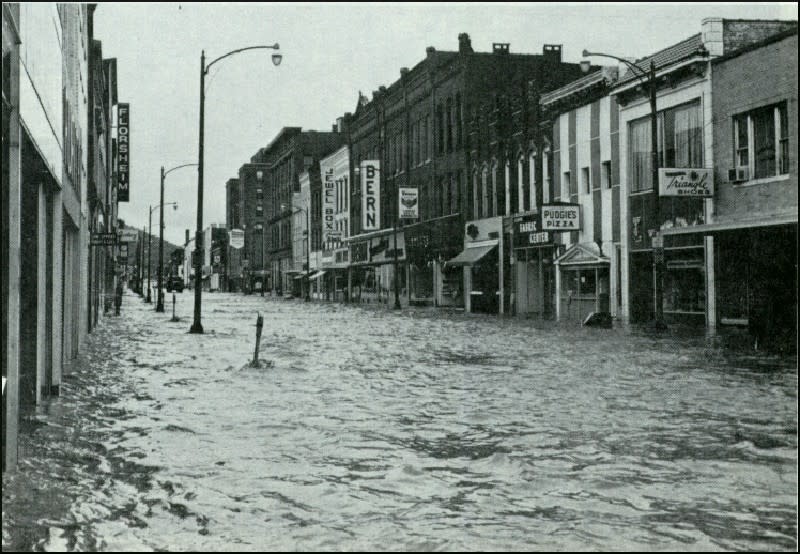
May is National Preservation Month, a special time dedicated to celebrating and reflecting on the historical layers that have shaped our communities. This year, Corning, New York, holds a place of particular significance as we celebrate the 50th Anniversary of the Market Street Restoration Agency. This blog will take you on a detailed journey through Corning’s rich tapestry of history, from its native roots to its bustling present, spotlighting the vital role of preservation in keeping our collective memory alive and honoring our shared heritage.
 Beginnings
Beginnings
Let’s travel back to the early 1600s when the Corning area first witnessed the presence of the Andastes (also called The Susquehannock), a significant Algonquin tribe. By 1672, after fierce conflicts with the Iroquois, the Andastes were nearly wiped out, and the territory came under the control of the Senecas, part of the formidable Iroquois League, which later expanded to become known as the Six Nations.
As we move into the late 18th century before Steuben County was even officially designated, the land that would become Corning was a portion of Painted Post in Ontario County. The area was on the brink of dramatic changes. In 1796, Steuben County was established as New York's 24th county, stitching together towns such as Bath, Canisteo, Dansville, Frederickstown, Middletown, and Painted Post. The growth was explosive—population-wise, soaring from a cozy 200 residents in 1790 to over 1,000 by 1796 and then doubling to more than 2,000 at the dawn of the new century. The land buzzed with activity as settlers like Frederick Calkins and Ephraim Patterson laid down the roots of the community, marking the beginnings of Corning's transformation from a few patches of land into a thriving, historic community.
Depiction of a Susquehannock male on John Smith's Map of Virginia, first published in 1612. The caption reads, "The Sasquesahanougs are a Gyant-like people & thus attired." Smith, John, 1580-1631. Hole, William, -1624. - http://hdl.loc.gov/loc.gmd/g3880.ct000377

Transformation
The year 1868 marked a pivotal moment for Corning, New York, with the arrival of Amory Houghton. Attracted by the promise of a skilled workforce and excellent transport links, he relocated his Brooklyn Flint Glass Works to Corning. The company rebranded as Corning Flint Glass Works, immediately dove into innovations in optical design, and started producing colorful glass for railroad signals, significantly influencing the safety and standards of America's burgeoning railroad network.
In 1875, the company took a significant step forward, incorporating as Corning Glass Works with Amory Houghton, Jr. at the helm. This period was marked by remarkable achievements, including the production of the first glass for Thomas Edison's lighting experiments in 1879, which positioned Corning at the heart of the electrification of America, supplying essential materials to giants like General Electric and Westinghouse. By the end of the century, Corning boasted a factory with ten massive chimneys and a blowing room stretching a massive 356 feet. However, by 1912, these coal-fired relics were replaced by gas furnaces, marking another phase of industrial evolution.
"Brooklyn Flint-Glass Works, New York" by John L. Gilliland & Co., engraved by James Smillie, 1852. Courtesy of the Rakow Research Library, Bib ID: 705090.

Flood and Renewal
The 1970s were challenging for Corning, with the city experiencing a downturn in population and a reduction in railway activity. The real test, however, came in 1972 when Tropical Storm Agnes unleashed flooding that caused unprecedented damage to the city. The floodwaters displaced over 6,000 residents, claimed 18 lives, and resulted in over $230 million in damages. But Corning's spirit was unbreakable. The community rallied together, with neighbors, emergency services, and organizations like the Red Cross stepping up in a massive cleanup and recovery effort.
This disaster became a catalyst for change. Post-flood recovery efforts led to significant urban renewal. With funds raised by United Way and initiatives by the Three Rivers Development Foundation, Corning witnessed a construction boom that transformed its landscape. New housing, upgraded public facilities, and a revitalized, pedestrian-friendly downtown emerged. Corning Glass Works, too, reflected the city's resilience, expanding and adapting to the new era.
Image from Market Street Restoration Agency, Flood of '72 Archives, June 1972. Courtesy of the Market Street Restoration Agency Archives.

Present Day
Today, Corning is a vibrant hub of innovation and culture, home to institutions like the Corning Museum of Glass, which attracts visitors worldwide. The city's downtown is a bustling center of art, dining, and historical architecture, where the community's pride in its beauty and history is palpable. This pride is celebrated annually at GlassFest, a vibrant May 24-26 festival that honors our unique glass-making heritage. Corning's journey from adversity to prosperity underscores the strength of the community and the enduring spirit of renewal. Through every trial, Corning has survived and thrived, demonstrating the power of unity and perseverance. This journey reminds us that a flourishing and dynamic future can rise from the ashes of adversity, rich in history and bright with promise.
 Buildings Alive Self-Guided Historic Walking Tour
Buildings Alive Self-Guided Historic Walking Tour
Downtown Corning has a rich history of architectural excellence that comes to life during our Buildings Alive Historic Walking tour!
